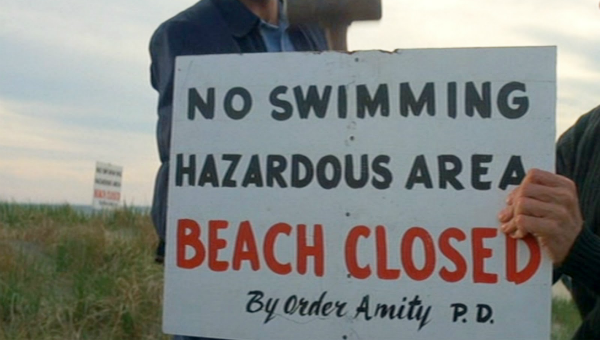httpvh://www.youtube.com/watch?v=U1fu_sA7XhE
‘None of men’s fantasies of evil can compare with the reality of JAWS’. So a radio commercial aired before, around and on June 20, 1975 proclaimed about the film that was to revolutionise industry practice.
For a hundred years since its creation in 1912, Carl Laemmle’s Universal Studios (home to stars like Rodolfo Valentino, Marlene Dietrich and Mickey Mouse, and to eminent film-makers like Alfred Hitchcock, David Lean, Laurence Olivier and Douglas Sirk to name a few) has been offering an incredibly wide repertoire of cinema in all its genres. Laemmle Jr. created in the early 1930s a successful niche of long-running series, also known as the ‘Universal Horrors’, the most memorable being FRANKENSTEIN, DRACULA, THE MUMMY and THE INVISIBLE MAN.
JAWS is one of cinema’s greatest gambles as well as successes…
Four decades later, Universal brought to screens worldwide a film which became the greatest financial prodigy of the time, grossing $100million dollars grossing. With a young, relatively unknown director behind the camera, and a movie studio unable to foresee the film’s potential, JAWS was one of cinema’s greatest gambles as well as successes. During the recession of the early 1970s, which coincided with Hollywood’s reinvention of the blockbuster, Spielberg became a reliable showman of New Hollywood with a career that speaks for itself. Blending low-cultural project with high-cultural artistry, JAWS became the ‘must-see’ event of 1975. The marketing campaign made history with its poster alone. TV spot adverts, pre-publicity and hundreds of simultaneous screenings made the summer of ’75 the centre of Hollywood’s earning year.
The ‘Great White’, remaining faceless for most of the film, elicits a variety of interpretations: ambiguity and uncertainty are the main constituencies of the genetic map of JAWS. It coincided with America’s withdrawal from Vietnam, its first military defeat: its characters and situations are evocative of the troubled waters and the atmosphere of mistrust in which American politics was finding itself.
‘obvious wish fulfilment narrative of the annihilation of a murderous, devious and implacable enemy’
Could the town’s Mayor Vaughn (Murray Hamilton), who insists on keeping the beach open for business reasons regardless of the evident danger, be paralleling President Nixon’s claims about ‘public interest’ and ‘national security’? Robert Torry read the film as an allegory of the US and Vietnam conflict: the fish, alias the Vietcong, prompts an ‘obvious wish fulfilment narrative of the annihilation of a murderous, devious and implacable enemy’ mostly unseen whilst mercilessly efficient (Torry in Nigel Morris, 2007:49). ‘The ultimately successful mission’, Torry claims, ‘provides its American audience with the satisfaction withheld … in Vietnam, that of the complete devastation of an elusive enemy’ (ibid.).
Furthermore, still in connection with the notion of wars, what about the US combat aeroplanes during WWII, with painted teeth on the engine cowlings, inviting us to equate the film’s shark with human barbarity in warfare?
The film runs on two binaries parallel and opposite: the recognisable, and the uncertain.
So, again, what is the horror that the film dramatises? Vietnam, or Watergate? People’s vulnerability under the attractive and yet strangling grasp of voracious capitalism? Or is the shark ‘the young man’s sexual passion (Biskind 1975:1) or a “vagina dentata” (Pollock 1976:41) threatening patriarchy? Unlike previous disaster movies of the decade, which called upon the wealth of celebrated stars to determine spectators’ satisfaction on all sides of the spectrum, JAWS eschews the mechanism of ‘safe stardom’. Instead, it subtly tricks the spectator’s psyche by first offering the apparent clarity that the high awareness of the animal presents, while simultaneously plunging them into the foggy waters of ‘known chaos’. The film runs on two binaries parallel and opposite: the recognisable, and the uncertain.
Where can the spectators find their anchor of safety? Who are the heroes?
Avoiding fixed, clear generic patterns and conventions, and yet appearing to be clearly classifiable, the film destabilises expectation through its hybrid nature. It secures and satisfies a wide target audience, by offering ‘a potentially wider tonal range, possibly enriching the permutations of emotional, visceral or intellectual impact’ (Morris, 2007: 57). These very same qualities undermine the perfection of the world that JAWS recreates, a world where, from under the surface, a volcano of unknown forces is erupting in all its brutal and unforgiving violence. Where can the spectators find their anchor of safety? Who are the heroes? The three men leading the hunt, all ordinary men in a way, or the other problematic characters?
John Williams’ distinctive soundtrack, making ingenious use of a rich new standard of sound-effects, together with Verna Field’s disorientating and anxiety inducing editing style, takes the spectators beyond the everyday experience whilst referring to a familiar one. Even before the credits begin, Williams’ masterful sound and score designs place the spectator in a state of alertness, whilst the forward tracking opening shot follows the still unrecognised source of malice; notably, ‘no one in the audience screams when Chrissie is killed […], but they did when the shark’s head and jaws rose out of the water into human space’ (Rubey 1976:23). The spectators are aligned, or even (one might dare to say) identified with the vicious shark, through repeated underwater point of view shots throughout the film, and they wish to break free from an instinctive voyeuristic drive to look at/eat the Others. Then, suddenly, they become the Others, vulnerable to the all-seeing/all-eating powerful camera/shark.
It is under this constant dual trajectory that JAWS bears traces of the deep divisions in American society, and becomes a spectacle of the fragility of a nation ensnared in contradictions and, also, more universally, of human nature. Leaving us to ponder, having watched it again 37 years after its spectacular release, ‘Who are the real sharks?’
Happy 100 Year Anniversary, Universal! God Bless America … and its waters …!




Crikey Loreta! I’m not sure anybody but the critic put that much thought into a film (but that is half the fun of being a critic after all). The story’s roots as Ibsen’s Enemy Of The People means most of these themes were already there, they just tumble out when the film is shaken, like detritus from a young boys pocket.
And the low culture delivered as high culture had already been done with The Godfather. It was the directorial talent of Coppola and Spielberg that stopped these films being what I’m sure the studio would have been happy with: companion pieces to the Airport/Irwin Allen blockbusters. Reinvented is right though – there is strong case that rather than ruin Hollywood with populist entertainment the movie brats helped at least make sure the populist entertainment was watchable.
God, I’m stalking these comment sections of late.